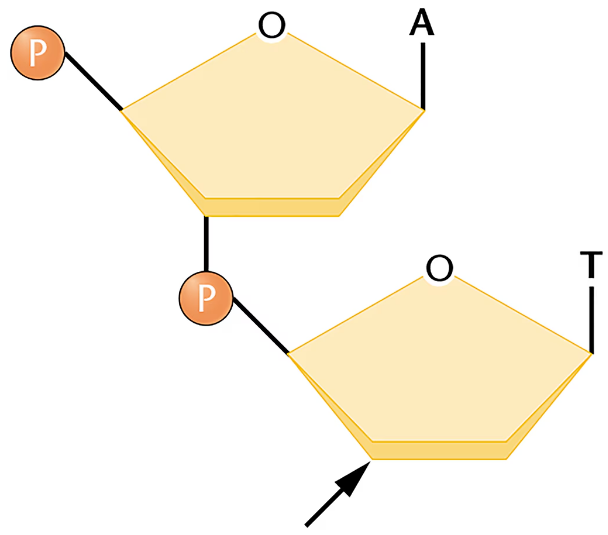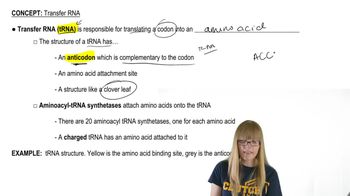One of the most common spontaneous lesions that occurs in DNA under physiological conditions is the hydrolysis of the amino group of cytosine, converting the cytosine to uracil. What would be the effect on DNA structure of a uracil group replacing cytosine?
Table of contents
- 1. Introduction to Genetics51m
- 2. Mendel's Laws of Inheritance3h 37m
- 3. Extensions to Mendelian Inheritance2h 41m
- 4. Genetic Mapping and Linkage2h 28m
- 5. Genetics of Bacteria and Viruses1h 21m
- 6. Chromosomal Variation1h 48m
- 7. DNA and Chromosome Structure56m
- 8. DNA Replication1h 10m
- 9. Mitosis and Meiosis1h 34m
- 10. Transcription1h 0m
- 11. Translation58m
- 12. Gene Regulation in Prokaryotes1h 19m
- 13. Gene Regulation in Eukaryotes44m
- 14. Genetic Control of Development44m
- 15. Genomes and Genomics1h 50m
- 16. Transposable Elements47m
- 17. Mutation, Repair, and Recombination1h 6m
- 18. Molecular Genetic Tools19m
- 19. Cancer Genetics29m
- 20. Quantitative Genetics1h 26m
- 21. Population Genetics50m
- 22. Evolutionary Genetics29m
7. DNA and Chromosome Structure
DNA Structure
Problem 30a
Textbook Question
Consider the drawing of a dinucleotide below.
Is it DNA or RNA?

 Verified step by step guidance
Verified step by step guidance1
Examine the sugar molecule in the nucleotide structure. If the sugar is deoxyribose (lacking a hydroxyl group at the 2' carbon), it is DNA. If the sugar is ribose (with a hydroxyl group at the 2' carbon), it is RNA.
Look at the nitrogenous bases attached to the sugar. Both DNA and RNA can have adenine (A), guanine (G), and cytosine (C). However, DNA contains thymine (T), while RNA contains uracil (U). Identify the base to help determine the type of nucleic acid.
Check the overall structure of the molecule. DNA is typically double-stranded and forms a double helix, while RNA is usually single-stranded. However, this may not always be visible in a dinucleotide structure.
Consider the context of the question. If the molecule is labeled or described as part of a specific biological process (e.g., transcription), this might provide additional clues about whether it is DNA or RNA.
Combine the observations from the sugar, nitrogenous base, and structural context to conclude whether the dinucleotide is DNA or RNA.
 Verified video answer for a similar problem:
Verified video answer for a similar problem:This video solution was recommended by our tutors as helpful for the problem above
Video duration:
1mPlay a video:
Was this helpful?
Key Concepts
Here are the essential concepts you must grasp in order to answer the question correctly.
Nucleic Acids
Nucleic acids, including DNA and RNA, are polymers made up of nucleotide monomers. Each nucleotide consists of a sugar, a phosphate group, and a nitrogenous base. The sequence and type of these components determine the structure and function of the nucleic acid, which is crucial for genetic information storage and transfer.
Recommended video:
Differences Between DNA and RNA
DNA (deoxyribonucleic acid) and RNA (ribonucleic acid) differ primarily in their sugar components and nitrogenous bases. DNA contains deoxyribose sugar and the bases adenine, thymine, cytosine, and guanine, while RNA contains ribose sugar and substitutes uracil for thymine. These differences affect their stability, structure, and roles in the cell.
Recommended video:
Dinucleotide Structure
A dinucleotide consists of two nucleotides linked by a phosphodiester bond, which forms the backbone of nucleic acids. The specific arrangement of the sugar and phosphate groups, along with the attached nitrogenous bases, can indicate whether the molecule is DNA or RNA. Recognizing these structural features is essential for identifying the type of nucleic acid.
Recommended video:
Guided course

Ribosome Structure
Related Videos
Related Practice
Textbook Question
587
views




